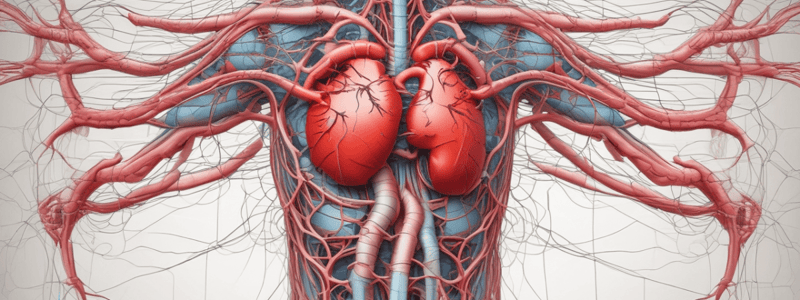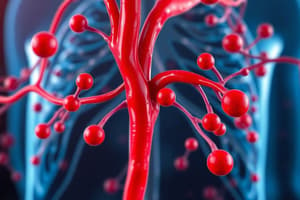Podcast
Questions and Answers
What primarily enables the transport of oxygen and nutrients in complex multicellular organisms?
What primarily enables the transport of oxygen and nutrients in complex multicellular organisms?
- Diffusion alone
- Muscle contractions
- Simple cellular transport mechanisms
- A circulatory system (correct)
Which law describes the relationship between flow, pressure difference, and resistance in fluid dynamics?
Which law describes the relationship between flow, pressure difference, and resistance in fluid dynamics?
- Darcy's Law (correct)
- Archimedes' Principle
- Newton's Law of Gravitation
- Bernoulli's Principle
In terms of flow properties, how do laminar and turbulent flows differ?
In terms of flow properties, how do laminar and turbulent flows differ?
- Turbulent flow occurs only in very small vessels
- Laminar flow has higher resistance than turbulent flow
- Laminar flow is more efficient in transporting fluids (correct)
- Turbulent flow is characterized by smooth, parallel layers
What is the effect of tubes arranged in series on total resistance compared to tubes arranged in parallel?
What is the effect of tubes arranged in series on total resistance compared to tubes arranged in parallel?
How many beats does the human heart approximately make in a lifetime?
How many beats does the human heart approximately make in a lifetime?
What is the primary role of the cardiovascular system beyond transportation of substances?
What is the primary role of the cardiovascular system beyond transportation of substances?
What is the primary factor that influences the permeability of a substance?
What is the primary factor that influences the permeability of a substance?
According to Darcy’s Law, what happens to flow if the resistance to flow increases?
According to Darcy’s Law, what happens to flow if the resistance to flow increases?
Which of the following relationships between vessel radius and flow rate is correct?
Which of the following relationships between vessel radius and flow rate is correct?
In the context of Poiseuille’s Law, what does a small radius of the vessel significantly affect?
In the context of Poiseuille’s Law, what does a small radius of the vessel significantly affect?
Which of the following correctly describes the relationship between pressure difference and flow?
Which of the following correctly describes the relationship between pressure difference and flow?
What is implied when the resistance to flow is said to be proportional to the fourth power of the radius?
What is implied when the resistance to flow is said to be proportional to the fourth power of the radius?
What is the effect of a 20% reduction in radius on resistance and flow?
What is the effect of a 20% reduction in radius on resistance and flow?
Which stimuli are primarily responsible for vasoconstriction?
Which stimuli are primarily responsible for vasoconstriction?
How does blood viscosity affect resistance to flow?
How does blood viscosity affect resistance to flow?
What accounts for the non-Newtonian behavior of blood?
What accounts for the non-Newtonian behavior of blood?
What occurs during vasodilation?
What occurs during vasodilation?
Which of the following statements about blood is true?
Which of the following statements about blood is true?
Which factor does NOT directly influence the rate of diffusion according to Fick's Law?
Which factor does NOT directly influence the rate of diffusion according to Fick's Law?
What role does the square root of the molecular weight play in the rate of diffusion?
What role does the square root of the molecular weight play in the rate of diffusion?
What primarily drives the diffusion process in gases according to the content?
What primarily drives the diffusion process in gases according to the content?
How does an increase in thickness of the diffusion barrier affect the rate of diffusion?
How does an increase in thickness of the diffusion barrier affect the rate of diffusion?
What is the role of solubility in the rate of diffusion?
What is the role of solubility in the rate of diffusion?
According to Fick’s Law, which equation correctly represents the rate of diffusion?
According to Fick’s Law, which equation correctly represents the rate of diffusion?
What effect does increased blood flow have on the diffusion of gases?
What effect does increased blood flow have on the diffusion of gases?
Which of the following best describes the effect of surface area on the diffusion of substances?
Which of the following best describes the effect of surface area on the diffusion of substances?
What phenomenon describes the alignment of cells in the fastest-moving fluid?
What phenomenon describes the alignment of cells in the fastest-moving fluid?
How does the size of red blood cells relative to capillaries affect viscosity?
How does the size of red blood cells relative to capillaries affect viscosity?
What is the primary consequence of turbulence in blood flow?
What is the primary consequence of turbulence in blood flow?
What condition can result from very high viscosity due to an increased red cell count?
What condition can result from very high viscosity due to an increased red cell count?
What effect can high velocity blood flow due to narrowed heart valves have?
What effect can high velocity blood flow due to narrowed heart valves have?
What is the Fåhraeus-Lindqvist effect primarily associated with?
What is the Fåhraeus-Lindqvist effect primarily associated with?
Which factor is most likely to cause turbulence in fluid flow within tubes?
Which factor is most likely to cause turbulence in fluid flow within tubes?
What is one potential consequence of turbulence in airways?
What is one potential consequence of turbulence in airways?
Flashcards are hidden until you start studying
Study Notes
Overview of the Cardiovascular System
- Circulatory systems are crucial for transporting oxygen, nutrients, and waste products in multicellular organisms.
- Diffusion alone is inadequate for complex organisms; bulk flow is needed for efficient transport.
- Regulation of blood flow is essential for homeostasis in response to environmental changes.
Key Principles of Flow and Pressure
- Flow through tubes is influenced by:
- Pressure differences and tube calibre.
- Resistance to flow and fluid viscosity.
- Darcy's Law: Flow is proportional to pressure difference (P1 - P2) and inversely proportional to resistance (R).
- Poiseuille's Law defines resistance: R = (8VL) / (πr⁴).
Types of Flow
- Laminar flow: Fluid moves smoothly in parallel layers; affected by viscous drag and tube diameter.
- Turbulent flow: Disrupted flow due to high velocity, sharp edges, or abrupt changes; significantly increases resistance.
Factors Affecting Resistance
- Vessel radius has a dramatic impact: Resistance is inversely proportional to the fourth power of radius.
- A small radius change can lead to substantial changes in resistance and flow rates.
- Arterioles can change radius via:
- Vasoconstriction (increases resistance) through stimuli like noradrenaline and angiotensin II.
- Vasodilation (decreases resistance) through stimuli such as adrenaline and histamine.
Diffusion and Fick’s Law
- Fick's Law of diffusion states that the rate depends on:
- Area of diffusion (A), thickness of barrier (T), and concentration difference (C1 - C2).
- Solubility and molecular weight of the substance also play roles.
- Diffusion is slow over large distances; hence, adequate flow is necessary to transport substances.
Characteristics of Blood Flow
- Blood viscosity is significantly higher than water due to red cell mass and plasma proteins; it is a non-Newtonian fluid.
- In small vessels, axial streaming reduces effective viscosity, enhancing flow.
- High red cell counts can increase total peripheral resistance (TPR) leading to hypertension.
Implications of Turbulence
- Turbulence arises from high velocity flow, sharp edges, and branch points.
- It escalates resistance and may cause murmurs in blood flow or wheezing in airways.
- Disrupted flow can result in vessel wall damage and trigger clotting processes.
Distensible vs. Rigid Tubes
- Flexible and distensible vessels exhibit different flow dynamics compared to rigid tubes.
- Myogenic tone in blood vessels contributes to overall regulation of flow and pressure management.
Studying That Suits You
Use AI to generate personalized quizzes and flashcards to suit your learning preferences.




